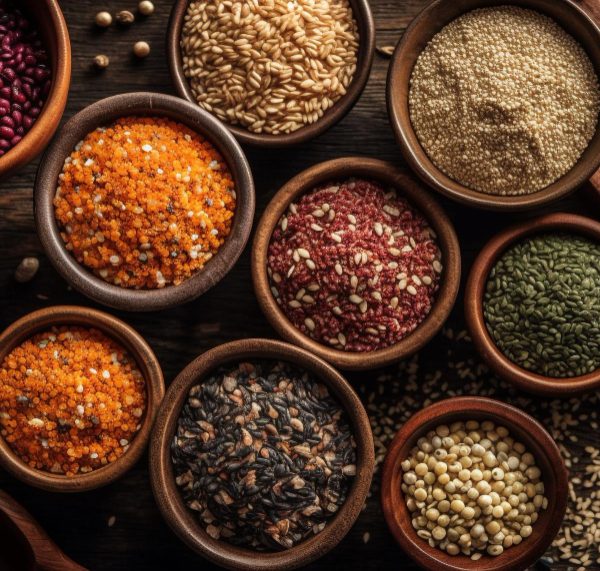Elevate Your Plate
Welcome to a culinary journey where health meets flavor – introducing Magicana Millets. Sourced from the heart of nature and cultivated with care, our millets are versatile, nutritious, and a delightful addition to your wholesome lifestyle.
At MagicStone Global Exports, our commitment to providing you with the finest and healthiest products is fortified by government approval. Our Millets Collection stands as a testament to this commitment, having received the esteemed recognition from the Government of India.

Why Choose Magicana Millets?
Inspiring Healthier Habits
Nutrition Without Compromise
Quality from Farm to Fork
Magicana Millets

Millets
India leads global millet production with a substantial 41% share, contributing 12.49 million metric tonnes in 2020. Notably, millet production in India surged by 27% in 2021-22, reaching 15.92 MMT. Top producers include Rajasthan, Maharashtra, Karnataka, Gujarat, and Madhya Pradesh. Despite a 1% export share, India's millet market is poised to grow from USD 9 billion to over USD 12 billion by 2025.
The government is fostering start-ups for millet exports, focusing on value-added products like RTE and RTS items. In FY 2021-22, India saw an 8.02% growth in millet exports, reaching 159,332.16 metric tonnes. Major export destinations include U.A.E, Nepal, Saudi Arabia, Libya, Oman, Egypt, Tunisia, Yemen, UK, and US, with varieties like Bajra, Ragi, Canary, Jawar, and Buckwheat.
On the global stage, Indonesia, Belgium, Japan, Germany, Mexico, Italy, the U.S.A, UK, Brazil, and Netherlands top the list of major millet importers. India contributes 16 key millet varieties, including Sorghum, Pearl Millet, Finger Millet, Minor Millets, Proso Millet, Kodo Millet, Barnyard Millet, Little Millet, Two Pseudo Millets, Amaranthus, and Brown Top Millet.

PEARL MILLET (Bajra)
Botanical Name : Pennisetum glaucum .L.
Availability : Round The Year
Pearl millet, scientifically known as Pennisetum glaucum, is a nutritious and drought-tolerant grain that plays a crucial role in many diets worldwide. With its origins in Africa and the Indian subcontinent, pearl millet thrives in arid regions, making it a resilient crop. This gluten-free grain is rich in essential nutrients, including protein, fiber, and various vitamins and minerals. Pearl millet is a staple in many traditional dishes, used in the preparation of flatbreads, porridges, and even fermented beverages. Its adaptability to harsh growing conditions and its nutritional profile make pearl millet a valuable and sustainable food source, contributing to global food security.

Finger Millet (Ragi)
Botanical Name : Eleusine coracana
Availability: Round The Year
Finger millet, scientifically known as Eleusine coracana, is a small-grained cereal crop celebrated for its exceptional nutritional content. Originating in Africa and Asia, this gluten-free millet is a powerhouse of nutrients, boasting high levels of calcium, iron, and fiber. Often referred to as "ragi," it is a versatile grain used in diverse culinary applications. Popular for its role in creating wholesome porridges, flatbreads, and nutritious snacks, finger millet stands out for its potential to address malnutrition and support a balanced diet. With its resilience to adverse growing conditions, finger millet is a sustainable and vital crop that contributes significantly to both food security and nutritional well-being.

Kodo Millet
Botanical Name : Paspalum scrobiculatum
Availability: Round The Year
Kodo millet, scientifically known as Paspalum scrobiculatum, is a nutritious and gluten-free grain that holds a special place in traditional diets, particularly in India. This resilient millet is valued for its adaptability to diverse agro-climatic conditions, thriving in both arid and semi-arid environments. Kodo millet is a rich source of essential nutrients such as fiber, vitamins, and minerals, contributing to a well-rounded and healthy diet. Commonly used in the preparation of porridges, flatbreads, and diverse culinary dishes, it has gained popularity for its nutty flavor and nutritional benefits. Beyond its culinary uses, the cultivation of kodo millet promotes agricultural diversity and sustainability, making it an important crop in efforts towards resilient and varied food systems.

Little Millet
Botanical Name : Panicum sumatrense
Availability: Round The Year
Little millet, scientifically known as Panicum sumatrense, is a small-grained cereal that holds nutritional importance, particularly in South Asia. This gluten-free millet is rich in essential nutrients such as iron, fiber, and B-complex vitamins. Despite its small size, little millet packs a powerful nutritional punch. It is a versatile grain commonly used in the preparation of porridges, upmas, and various traditional dishes. Little millet is prized for its adaptability to diverse agro-climatic conditions, making it a resilient and sustainable crop choice. As a nutritious and gluten-free alternative, little millet contributes to diversified diets and supports sustainable agriculture practices, emphasizing its significance in promoting both human nutrition and environmental sustainability.

Foxtail Millet (Kangni)
Botanical Name :Setaria italica
Availability: Round The Year
Foxtail millet, scientifically known as Setaria italica, is a nutrient-dense grain with origins in East Asia. This gluten-free millet has gained popularity for its versatility and nutritional benefits. It is a rich source of carbohydrates, dietary fiber, and essential minerals such as iron and copper. Foxtail millet is a key ingredient in various traditional dishes, including porridges, upmas, and fermented products. Its rapid growth and ability to thrive in arid conditions make it a sustainable crop choice. Additionally, the low glycemic index of foxtail millet makes it suitable for individuals managing blood sugar levels. With its adaptability, nutritional profile, and culinary uses, foxtail millet contributes to diversified diets and sustainable agriculture practices.

Proso Millet
Botanical Name :Panicum miliaceum L.
Availability: Round The Year
Proso millet, scientifically known as Panicum miliaceum, is a versatile and nutritious grain that has been cultivated for centuries across different continents. Originating in Asia, it has become a staple crop in various regions due to its adaptability to different climates and soils. Proso millet is gluten-free and rich in essential nutrients, including protein, fiber, and B-complex vitamins. Its mild, nutty flavor makes it suitable for a variety of culinary applications, from porridges and cereals to baked goods and side dishes. This millet variety also plays a role in sustainable agriculture, as it requires less water compared to some other cereal crops. As a result, proso millet contributes to both diversified diets and environmentally friendly farming practices.

Barnyard Millet (Sama)
Botanical Name : Echinochloa frumentacea
Availability: Round The Year
Barnyard millet, scientifically known as Echinochloa esculenta, is a small-grained cereal that holds nutritional significance and versatility. Originating from Asia, particularly in India, this millet is celebrated for its rapid growth and ability to thrive in marginal soils with minimal water requirements. Gluten-free and rich in fiber, iron, and calcium, barnyard millet offers a nutritious alternative for those seeking a balanced diet. Its subtle, nutty flavor makes it adaptable to various culinary uses, from porridges and rice substitutes to baked goods. In addition to its nutritional benefits, the cultivation of barnyard millet supports sustainable agriculture practices, as it can grow in diverse agro-climatic conditions. Overall, barnyard millet contributes to promoting food diversity, nutrition, and environmental sustainability.

Sorghum Millet (Jowar)
Botanical Name : Sorghum bicolor
Availability: Round The Year
Sorghum, scientifically known as Sorghum bicolor, is a versatile and drought-tolerant cereal grain with a global presence. Originating in Africa, it has become a staple crop in various regions, including Asia and the Americas. Sorghum is gluten-free and rich in dietary fiber, providing a good source of energy. This grain comes in different varieties, including sweet and grain sorghum, each with distinct uses. Sweet sorghum is known for its sweet stalks, often used in the production of syrup and biofuel, while grain sorghum is a key ingredient in various culinary applications, such as porridges, flatbreads, and brewing. Beyond its nutritional value, sorghum's resilience to harsh conditions makes it a crucial component of sustainable agriculture, contributing to food security and diversified farming practices worldwide.
Your Trust, Our Credential
- Nsectetur cing elit.
- Suspe ndisse suscipit sagittis leo.
- Entum estibulum dignissim epeat.
Your Trust, Our CredentialS
- Nsectetur cing elit.
- Suspe ndisse suscipit sagittis leo.
- Entum estibulum dignissim epeat.

Why Should You Choose Kitecs?
We’re Award Winnings Studio
Choose Your Optimal Pricing Plan
Lorem ipsum dolor sit amet, consectetuer adipiscing elit sed diam nonummy nibh euismod tincidunt ut laoreet dolore magna aliquam erat volutpat.
Interior Sketch
There are many variations of passages of Lorem Ipsum available, but the majority have suffered.
3D Modeling
There are many variations of passages of Lorem Ipsum available, but the majority have suffered.
Room Measurement
There are many variations of passages of Lorem Ipsum available, but the majority have suffered.
Standard Business
- 3D Visualization
- Planning Solution
- Selection of Materials
- 10 Construction Drawings
Large Business
- 3D Visualization
- Planning Solution
- Selection of Materials
- 15 Construction Drawings






